A basic understanding of dog paw anatomy is useful for most dog parents so they can figure out what is normal and what is not. To help you care for and protect your pup’s paws, integrative veterinarian Dr. Julie Buzby explains the relevant anatomy and discusses a few common paw problems.
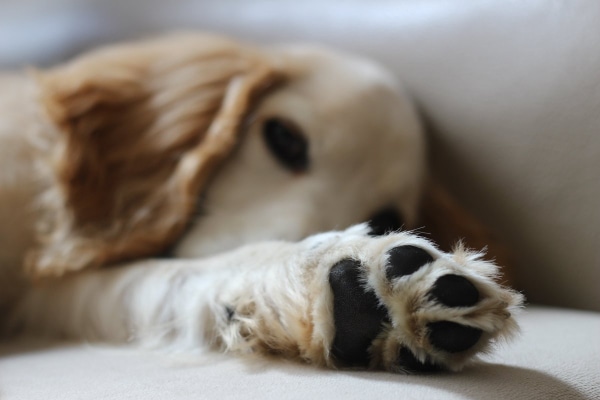
Recently, my client brought her Schnauzer to see me for a wellness exam. As we were talking about dog nail trims, she asked me about her dog’s paws. I was happy to share a quick dog paw anatomy lesson with her. And I want to “paws” to share some of the same information about dog paws with you too.
Why care about dog paw anatomy?
Just like our own feet, dogs’ paws play a huge role in their everyday activities. As you can imagine, healthy paws are important for walking comfortably. The pads on the bottom of the foot act as shock absorbers to help cushion and protect the bones of the paw as your dog runs and plays. If they weren’t there, the foot bones would be making contact with the ground, which would be quite painful.
The paw also houses a dog’s “traction devices,” the toes and toenails. When dogs walk, they use their toes to grip the ground, sort of like soccer cleats. This helps them to walk, run, twist, and turn without slipping and sliding. (This concept of how dogs use their toenails for traction is also what is behind my signature product, Dr. Buzby’s ToeGrips® dog nail grips.)
With all of these important roles, it is no surprise that untreated foot issues can cause:
- Balance issues
- Muscle wasting
- Strained joints
- Increased risk of falling
- Improper skeletal alignment
Additionally, changes in your dog’s paws can sometimes clue you in to other health problems. For example, the feet are often one of the first locations where signs of seasonal or food allergies show up. Also, the paws are a great place for foreign bodies like foxtails to hide.
In short, paws are important to your dog. So keeping them healthy and knowing how to spot problems is important for dog parents. But in order to do that, you have to understand a bit of normal dog paw anatomy.
Dog paw anatomy 101
If you pick up your dog’s foot and look at the bottom of it next to your own hand, you will see that the overall structure is very similar. A dog’s foot has a large central pad (similar to our palm) with several smaller toes and pads on one end of it (like our fingers). And dogs have toenails, just like we have fingernails and toenails.
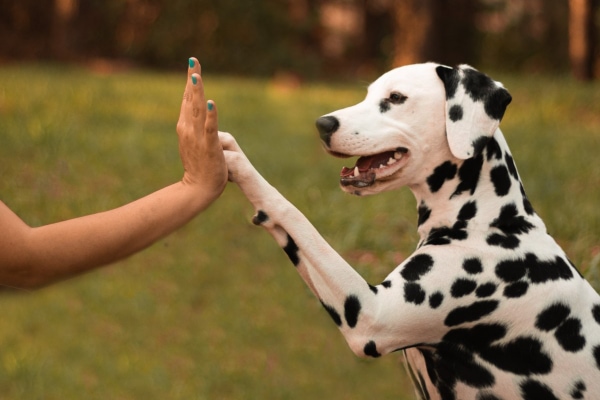
(It is important to note that, unlike our hands and feet, your dog’s front and back paws look almost identical. Therefore, most of the anatomy that we discuss will be the same between the two sets of paws. There are only a few minor differences that I will be sure to mention.)
Paw pads
Start by focusing on the center of the bottom of your dog’s foot. The big pad on your dog’s front paw is called the metacarpal pad. And on the dog’s rear paws, it is called the metatarsal pad. This pad is essentially the same on the front paws as the back ones but has a different name.
Now look for the small round pads that correspond with each of your dog’s toes. These are called digital pads. Since dogs have four toes on each foot (front and hind), they also have four digital pads on each foot.
The metacarpal/metatarsal and digital pads are the main “load-bearing” parts of the paw. They contain fatty tissue that cushions and protects your dog’s bones when walking and running. And the outer layer of the paw pads is thick and tough to protect your dog’s feet from rough terrain.
When looking at your dog’s hind paws, the pads we just discussed are typically the only ones (unless your dog has rear dewclaws). However, the front paws do have one or two bonus paw pads.
Additional paw pad on the front paw
The first additional paw pad is a carpal pad. It is located farther up your dog’s front leg—almost at the level of what you would consider your dog’s wrist. The carpal pad does not make contact with the ground when your dog walks. However, your dog may sometimes use it when climbing, or if he or she comes to a sliding stop after running.
The second pad, which a dog may or may not have, is the dewclaw pad. As the name implies, this is a very small pad located next to the dewclaw. Most dogs only have dewclaws (and dewclaw pads) on the front paws, if they have them at all. However, there are a few breeds who have rear dewclaws and therefore have dewclaw pads on their rear feet too.
Toes
Next, take a look at your dog’s toes and toenails. As I mentioned, all dogs have four weight-bearing toes on each foot, and each is made up of individual bones. However, there can be some variation in what the toes look like.
For example, if the two central toes are elongated and give your dog a more oval-shaped foot, then your dog has hare feet (just like the shape of a bunny foot). The longer toes are designed to increase speed so this foot shape is common in breeds like Greyhounds and Doberman Pinschers.
Also, some dogs have webbed feet. This simply means that there is increased webbing (or skin) between the toes. The webbing is important to help with swimming, tolerating hot surfaces, digging, and wading through mud and snow. Many dog breeds have webbed feet — including Portuguese Water Dogs, Labrador Retrievers, and Dachshunds.
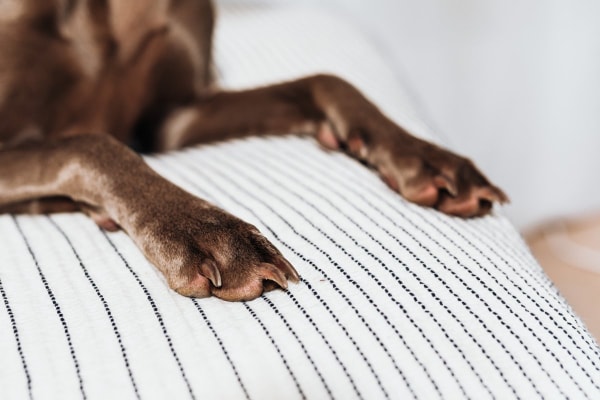
Toenails
You will also notice that each toe has a toenail associated with it. Unlike in cat feet, dogs cannot retract their toenails. In a normal, healthy paw, the nails should point forward toward the head. Normal nails also curve slightly toward the paw pad associated with the nail.
However, the toenails should not curve enough that they touch the paw pad. And they shouldn’t be forced sideways when a dog stands. If either of these things happens, the nails are too long and need to be trimmed.
We will talk more about nail trims in a bit, but it is important to know the relevant dog toenail anatomy too. Toenails have a hard outer shell, which is either clear or black. This is the insensitive portion you cut off when trimming your dog’s nails. Toenails also have a sensitive inner core made up of blood vessels and nerves. This is the part that hurts and bleeds if you cut a nail too short.
Dewclaws
Once you have investigated the four main toenails, slide your hand up your dog’s front leg to feel for the dewclaw (i.e. fifth nail). If present, it is usually located on the inner surface of the leg, just below the “wrist.”
The main function of the dewclaw seems to be aiding in climbing and jumping. However, not all dogs have the same number or have them at all. As discussed when talking about dewclaw pads, most dogs either have no dewclaws or only have dewclaws on their front feet. But some dogs also have them on the back feet.
Dewclaws can be “floppy” or “attached,” depending on how closely associated the nail is to your dog’s “wrist.” Out of the two types, floppy dewclaws are the most likely to be snagged or broken because they are only attached by the skin. Attached dewclaws, on the other hand, have a bony attachment and are more stable.
Sweat glands
While not visible to our eyes like the paw pads, toenails, and dewclaws, dogs also have sweat glands in their feet. Interestingly, dogs only sweat through their feet. Even though panting is the main mechanism that helps dogs cool down on a hot day, their “sweaty feet” can also help lower their body temperature.
Also, as an added fun fact, the sweat glands on the feet are the reason your dog’s feet might smell like a bag of chips! The warm, moist environment can trap bacteria and odor, leading to “Frito feet.”
7 Common dog paw problems
Now that we have covered all the relevant dog paw anatomy, it is time to talk a little about what can go wrong with a dog’s paw. As you evaluate your dog’s feet, you will want to keep an eye out for these seven conditions.
#1: Long toenails
Long nails are probably the most common foot problem for most of my patients. There are a variety of reasons that the nails may become overgrown, but the end result is the same—pain and difficulty moving around.
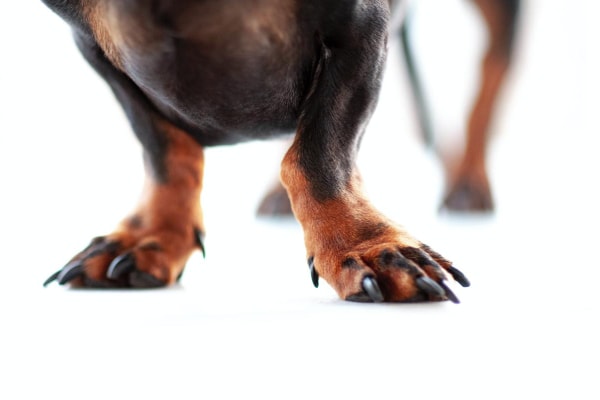
More specifically, I tend to see three main problems:
- Altered gait—Dogs with long nails can develop an abnormal gait. This can eventually predispose your dog to osteoarthritis in dogs or hip and shoulder problems.
- Slipping—Overgrown nails prevent your dog from being able to properly grip the ground while walking. On grass or rough surfaces, your dog normally digs his or her nails into the ground for traction. But if the nails are long, especially on smooth surfaces, the dog can’t get enough traction to prevent slipping.
- Ingrown nails—Extremely long nails can become embedded in the dog’s paw pads. If you have ever had an ingrown toenail, you know this is very painful. The same goes for dogs because the nails are sharp and can puncture the pad. This creates an open wound that can become swollen and infected.
Solutions for long nails
If you notice these problems (or ideally before the long nails cause problems), it is important to cut the nails back to a proper length and keep them that way. I know for many people, this is easier said than done. Nail trimming can be challenging, but I’m here to say it doesn’t have to be.
I want to invite you to check out a few of my blogs on nail trimming (because if you can’t tell, nail trimming is a topic that is near and dear to my heart):
- 7 Tips for Successful Dog Nail Trims
- Best Dog Nail Clippers for “DIY” Dog Owners
- Clipped Your Dog’s Toenail Too Short? Sure-Fire Tips to Stop the Bleeding
- How to Clip Dog Nails: Turning Scary Task into Success
Alternatively, if you are looking for an in-depth approach to learning how to cut your dog’s nails at home, you may benefit from my master class, How To Trim Your Dog’s Nails Without Blood, Sweat, Or Tears.
Note: If your dog has nails embedded into the paw pads, please consult your veterinarian even if you can trim the nails yourself. Your dog’s foot might be painful or infected, and your dog may need anti-inflammatories, antibiotics, or other treatments in addition to the nail trim.
Finally, I want you to know that there is no shame in needing to ask for help. Nail trimming at home isn’t possible for every person, dog, and situation. Sometimes the best thing you can do is to have the veterinary team trim your dog’s nails or help you do some troubleshooting.
#2: Poor traction
As mentioned above, long nails can lead to poor traction. But sometimes even dogs with normal-length nails have trouble getting a grip on slippery surfaces. This is especially an issue for senior dogs, TriPawd® dogs, or those with other orthopedic issues.
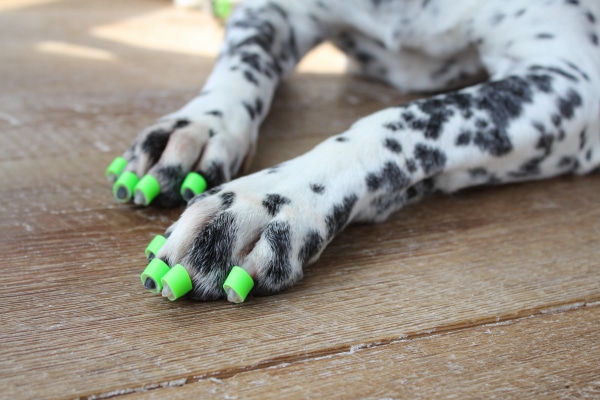
Luckily though, there is a safe and effective solution that goes everywhere your dog goes. That solution is my signature product, Dr. Buzby’s ToeGrips® dog nail grips. These small round grips fit onto your dog’s nails to enhance the natural gripping mechanisms of the toenails. This can help prevent slipping and falling and allow a dog to walk with confidence again.
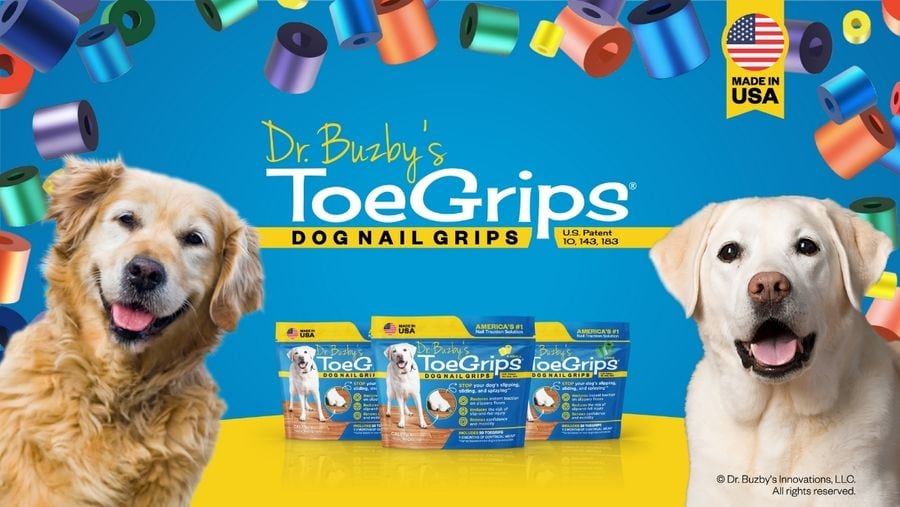
#3: Broken nails
Long toenails not only affect a dog’s gait and traction but also make it more likely that a dog will break a nail or rip it off entirely. This damage to the nail tends to occur when a dog is running or if he or she snags it while playing.
As you can imagine (or perhaps have experienced) a broken nail is very painful for your dog. If your dog ripped a nail off or breaks a nail, you might hear him or her yelp and see him or her start limping.
You also might notice blood coming from the broken nail. If this occurs, you can try to apply pressure to the nail (or apply Kwik Stop if you have some) to stop the bleeding. However, be careful when handling the broken nail. Even the nicest dog may snap or bite when he or she is in pain.
If there is more than a small chip out of the nail, the nail is bleeding, or the dog is painful, you should contact your veterinarian. He or she may want to bandage the foot and/or remove the rest of the broken nail. Plus, your dog may need antibiotics or pain medication.
#4: Foreign bodies in the paw
Depending on where you live, another common problem to be aware of is foreign material (e.g. foxtails) that can get lodged in a dog’s paw.
Grass awns, such as foxtails in dogs, like to become embedded in your dog’s fur and skin. Their arrowhead shape allows them to burrow deeply into your dog—making them easy to miss and difficult to remove. One of the most common locations for foxtails is between the toes of the paw.
A dog with a foreign object stuck in his or her foot may limp or excessively lick or chew at the foot. If you see those signs, take a close look at your dog’s foot, and pay special attention to the area between the toes.
Sometimes you may find a foxtail that is not embedded or buried yet. In that case, you can carefully attempt to remove it. However, if the foxtail is embedded, or your dog is painful, please contact your veterinarian immediately to have him or her remove it.
Remember that if you live or visit a location where foxtails or other grass awns are present, it is important to regularly look over your dog’s paws, ears, and body for any plant material. And if your dog walks where these pesky weeds live, it is best to examine his or her feet after every trip outside.
#5: Allergies and skin diseases
If your dog has been licking and chewing at his or her feet, and you don’t see a foreign body, the next condition to consider is allergies and/or other skin problems.
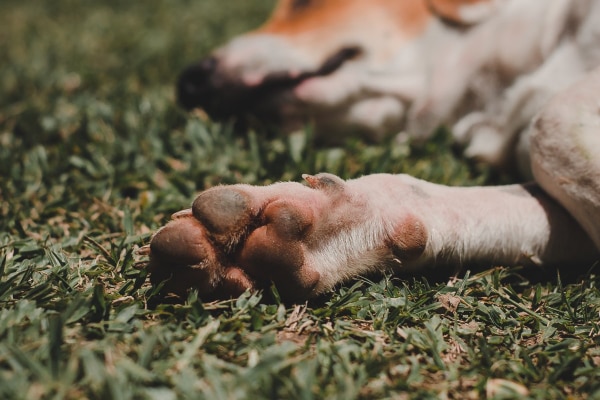
Dogs can be allergic to food, fleas, or things in the environment. But generally, a dog’s itchy paws are more likely to be a result of food or environmental allergies. Once something sets off the allergic reaction, the dog’s skin will become itchy, red, and irritated. In order to relieve the itching, the dog may lick or chew the area on the tops or bottoms of the feet, between the toes, around the nails, etc.
You might notice the skin on the paws turning red, becoming dry, or losing hair. Additionally, if you have a white or light-colored dog, the fur on the paw may turn reddish-pink due to the saliva from the dog’s excessive licking. Your dog may be scratching other areas or shaking his or her head due to otitis in dogs (i.e. an ear infection) as well.
All that licking and chewing of the paws can set up the perfect environment for a dog paw yeast infection or a bacterial skin infection (i.e. pyoderma in dogs). As a result, the feet can get even more irritated.
Additionally, dogs can have bacterial or yeast infections of their paws that are unrelated to allergies. Plus, they can develop interdigital cysts in dogs, which also lead to excessive licking and chewing. These pink-to-red nodules occur between the toes and can be quite painful and irritating for many dogs.
Management of skin problems
If the skin between your dog’s toes looks abnormal, or you suspect your dog may have allergies, the best thing you can do for your dog is to make an appointment with the veterinarian. He or she can evaluate your dog and then determine if allergy medication for dogs, antibiotics, antifungals, and/or another treatment is the right approach.
Sometimes it may take a bit of time and trial and error to find the combination that works best for your dog, so please be patient. Your vet wants to help your dog find relief as badly as you do.
#6: Paw pad burns
Another reason your dog’s feet might be painful is if he or she burned the paw pads. While the skin of the pads is very tough, it is still susceptible to burns just like the rest of the skin.
Paw pad burns occur more commonly when dogs are walked on hot pavement or asphalt in the summer. These surfaces become extremely hot and can cause thermal burns to the paw pads.
However, paw pad injuries may also occur if you walk your dog on extremely cold surfaces or roads that have been treated with certain ice melt products. (Plus, if your dog ingests ice melt, he or she could experience GI upset or more serious side effects.)
If any type of burn happens, it can be very painful for your dog. The pads can become tender to the touch, swollen, or blistered.
If you believe your dog has burned his or her paw pads, please take him or her to see the vet. Depending on the severity of the burn, your dog may need pain medication, bandages, or other treatments.
Keep in mind that when it comes to burns, prevention is the best medicine. Avoid walking your dog on very hot (or cold) surfaces. And if you must walk your dog, consider using PawZ dog boots. These rubber boots do a great job of protecting a dog’s feet from scalding pavement or ice melt products.
#7: Paw pad wounds
Burns are not the only type of wounds that can happen to your dog’s paws. If your dog plays on rough or rocky surfaces, he or she could develop cuts on the paw pads. And sharp objects like nails or sticks can become embedded in the foot. Additionally, running on an abrasive surface, such as a tennis court or the pavement, for a long period of time can cause paw pad blisters that may show up days later.
If you suspect anything is wrong with your dog’s foot, please examine it closely. Anytime you are unsure if there is a problem, you should always call your veterinarian. Your vet can help you assess the problem and decide if an exam and treatment are needed.
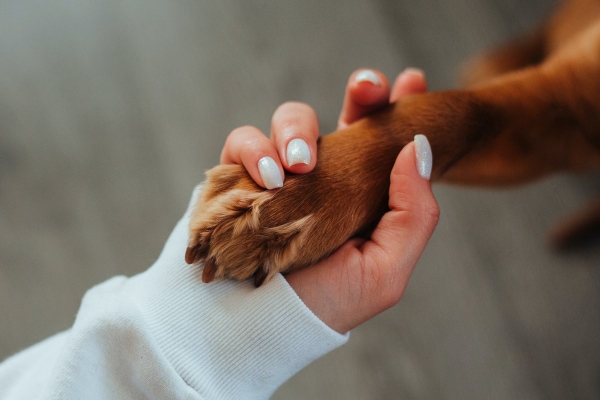
How do you care for your dog’s paws?
Your veterinarian can also help you learn how to keep your dog’s paws healthy to prevent paw problems. Some things he or she may recommend include:
- Keeping the nails trimmed at an appropriate length
- Trimming extra hair around your dog’s toes and toenails
- Checking the paw pads regularly for cuts and wounds
- Avoiding walking your dog on extremely hot or cold surfaces
- Checking the paws and between the toes for foreign bodies
- Monitoring your dog for signs of pain associated with the feet such as chewing, excessive licking, sensitivity, and limping
“Paws” to think about your dog’s paws
It is so important that you monitor and protect your dog’s paws. They are easy to overlook, but they are an important body part for your dog. Without healthy paws, it is hard for your dog to do all the fun activities that dogs love—swimming, running, jumping, digging, and playing. Plus, paw problems can make it difficult for you and your dog to enjoy those activities together.
As we have discussed, being familiar with dog paw anatomy and being able to recognize problems promptly can go far in helping your dog have healthy feet. Should you have any questions or concerns, please reach out to your veterinarian. He or she is always there to help and guide you along the way.
And finally, remember that happy feet mean a pawsitively happy dog!
Do you routinely examine your dog’s paws?
Please comment below.


My 6 month Doberman puppy has pullled
Ligament in her 2 centre toes on left front paw
Which has flattened the paw Vet says wait and see in your experience will the paw elevate
Or is she stuck with it for rest of her life
Best guess?? Thks
Hi Jane,
I am sorry your Doberman puppy has experienced this worrisome injury to her paw. Ligament injuries are able to heal in some cases, but they do tend to heal very slowly. It may be good to get an expert opinion from an orthopedic specialist. You girl may also benefit from some physical therapy/rehabilitation. Hoping you will start to see improvement soon and praying for a full recovery for your sweet pup.
How important is the outer pad on a front paw? Our 5 month old puppy seems to have a very small pad on the left leg compated to the right leg. Will this have an impact on movement?
Hi Carlie,
I understand your concern for your puppy with their paw pads being unsymmetrical. Without examining your dog myself, it is hard to make specific conclusions. It doesn’t sound like an emergency, but this definitely needs to be evaluated by your vet. They can let you know if this defect is anything to worry about or if it is just cosmetic. Hoping all is well and wishing your puppy the best of luck for a long and happy life.
Hello there Dr.Buzby ,
Lately I’ve noticed that my Lab/Pit mixed 1-yr old male dog has been doing a lot of excessive chewing and licking on his paws and itching around his face and ears .And as a result his paws and other areas are raw and bleeding and swollen.His name is Bepo and he is a large dog who is used to regular bathing and nail trimmings and regular pampering .This is the first time we have had a large yard with lots of grass and also neighbors with many many outside animals although they do not play with my dog we have seen an increase of fleas so he gets treatment regularly for this as well .But lately I’ve really noticed he is always
chewing and irritated in his skin,and he does not listen when told not to chew lol .I’ve tried the apple cider vinegar thinking his problem is a yeast issue and the allergy medicine equal to benadryl for allergy but it seems it’s not getting any better and now he is loosing his hair where before it was a gorgeous thick coat now looks thin and just not good.Any ideas on what I should try next I’d appreciate the help .thank you so much .
Hi Bobbijo,
I am sorry your young guy is dealing with this chronic chewing and itching. While allergies may be to blame, there are also many other possible causes that need to be investigated. What are you using for routine flea prevention? Or are you just treating him for fleas when you see them? It would be best to schedule an exam with your vet. They can help to narrow down the cause and offer guidance on how to give your boy some relief. Hoping for clear answers and an easy solution. Best of luck to you both!
my small pomchi jumped out of the truck when we got home due to excitement ( truck was parked) she yelped a little bit then started limping on her back paw, her nails are lo g but not to long to cause her pain, It’s been 2 days and she doesn’t want to step down on her paw her bones seem to be okay and I have moved her leg all around and massaged all around and her hip does not bother her at all, but once I touch her underneath her middle toe nail in between the nail and paw pad she flinched and snapped at me, so I think I have found what is bothering her but no sign of blood or scraps.. can the nail detach from the paw bed or how are the connected? to me this is what looks like has happened, someone help please and thank you 😊 and I can not afford a vet right now as I got laid off
Hi April,
I am sorry your little pup has injured her foot. Without examining her myself, it is hard to make specific conclusions, but I am suspicious she may have suffered a fractured toe. Without the presence of blood and since the nail itself looks normal, I would not think the nail is the issue. The nail grows out of the tissue at the end of the toe and if it had ripped loose there would definitely be blood involved. I understand money is tight right now and financial concerns can sometimes limit our options. Unfortunately, without having your vet evaluate the foot, I am not sure how to get a definitive diagnosis or offer the best treatment recommendation. Here is a link to an article with more information about broken toes: Dog Broken Toe? Expert Answers from a Vet
Try to encourage your girl to rest and restrict her activity for now. Hoping you can find a way to get her the medical attention she needs. Wishing you all the best and praying for a positive outcome.
hello,
my Labrador cracked his nail down to the pad and our vet had to remove it. it is growing out now but he is limping and we noticed a swollen nodule at the base of that toe where it meets the metatarsal.
Do you think this is related, or a secondary issue?
Hi Ann,
I am sorry your boy is having these painful issues with his toe. Without examining it myself, I can’t be sure if this is related to the original injury or not. I do think it needs to be evaluated by your vet and it sounds like x-rays may be in your future. Hoping for clear answers and successful treatment.
I’ve noticed lately that our mìniture Doxin has been walking on his metacarpal & matatrpal pads (front & back) and not on his toes. what or why would make him do that.
Hi Cindy,
There are numerous causes for this issue in dogs. Unfortunately, it would require some testing to rule out some of the possibilities (diabetes, Cushing’s, tendon/ligament issue, etc.). If your pup has not had any lab work done recently that would be a good place to start along with a physical exam. Hoping you can get some answers soon. Wishing you both the best of luck.
Thank you ,great advice.pP
Great article! I also love your how-to for nail clipping that you linked.
I have noticed that my dogs have different “feet-related” personalities.
Some have sensitive paws and dislike dog boots/nail trims while others tolerate both.
It is interesting to note that my dog with sensitive feet also has allergies that impact many areas including her feet.
Hi Sherri,
That is an interesting bit of information you have learned about your pup. I am willing to bet her foot sensitivity has something to do with the inflammation present from her allergies. I appreciate you sharing your experience with us. Thank you for the positive feedback!